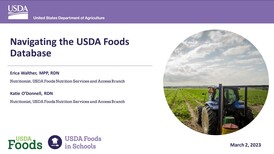
Sesame: The 9th Major Food Allergen
The Food Allergy Safety, Treatment, Education, and Research (FASTER) Act, a federal law passed in 2021, named sesame as the ninth major food allergen, requiring it to be declared on food labels effective January 1, 2023. Sesame joins the eight other major food allergens including milk, eggs, fish, Crustacean shellfish, tree nuts, peanuts, wheat, and soybeans. However, you may not see sesame listed as an allergen on food packages or a declaration included in the USDA Foods Database right away.
The law establishing sesame labeling does not require food products that were in distribution or inventory before January 1, 2023 to be removed from the marketplace or relabeled to declare sesame as an allergen. Depending on shelf-life, some food products may not have allergen labeling for sesame on the effective date. USDA Foods vendors are working to update their allergen information in the USDA Foods Database; however, currently there are some USDA Foods products without this declaration
During this transition period, it is important to proceed with caution, check the label every time a product is received, and contact vendors directly with questions about whether a product contains sesame. For more information on sesame allergen labeling and what to expect, please visit the FDA website.
|

Navigating the USDA Foods Database
On March 2, 2023, FNS hosted a webinar that provided state agencies and school districts with instructions on how to navigate the USDA Foods Database to access vendor-specific product information, including nutrients, allergens, ingredients and certifications. FNS shared important resources to help utilize the USDA Foods Database, including release notes, step-by-step written instructions, FAQs, and other useful information. The webinar included a live Q&A for attendees to get their most pressing USDA Foods Database questions answered. This webinar was intended for state agencies and school districts, and a recording can be found here.
|

American Commodity Distribution Association Annual Conference
This year, the American Commodity Distribution Association annual conference was held in Anaheim, California, from April 16-19. Members of the USDA Foods team attended the conference and presented on over ten different topics to conference attendees, as well as participating in panel discussions and Q&A sessions as both moderators and presenters. This conference was a great opportunity for USDA, States, Schools, Food Banks and Industry to come together under one roof to learn, share and network with a common goal of providing healthy foods to program participants.
Sessions presented by USDA Foods staff included:
- Understanding USDA Foods from Entitlement to Title Transfer
- Using FFAVORS to Manage USDA DoD Fresh
- The USDA Foods Database
- Promoting Local Foods in the USDA Supply Chain
|
New WBSCM Incident Reporting Tool
With the March 2023 release, users can submit incidents to the help desk from within Web-based Supply Chain Management (WBSCM). The form walks the user through the information needed to analyze issues and concerns. Providing these details with the initial incident helps the WBSCM Service Desk to resolve problems more quickly.
To enter an incident:
1. From the main page, click on Report Incident in the upper right area of the screen.
 2. Complete the WBSCM Incident form. First, select a type of incident. A short description and details about the issue, question, or suggestion are required. Include other information as relevant.
3. Upload a full-page screenshot. Guidance is available under the How to Get Full Page Screenshot
4. Upload additional attachments such as reports or data files, as needed.
5. Click Submit.
 After submitting an incident, users will receive an email to confirm that the WBSCM Service Desk has received the information.
All monthly changes are documented in the Release Notes, which may be accessed in WBSCM at Help > Training > Release Notes.
For questions about WBSCM, please use the new form to submit an incident or contact the WBSCM Service Desk.
WBSCM User Feedback Sessions
Based on interest expressed at the ACDA conference in April 2023, the Technology Branch has begun hosting WBSCM user feedback sessions for SDA and RA users. These sessions are an opportunity to identify customer pain points and potential areas for innovation in WBSCM. The first meeting was held earlier this month. If you are interested in participating in future sessions, please contact Samantha Escamilla.
System Releases & Announcements
- 06/25/2023 – FFAVORS 4.3 Release
- 06/29/2023 – WBSCM 2.06 Release
- 07/27/2023 – WBSCM 2023R4.2.07 Release
Planned dates for system activities are subject to change.

SNA Annual National Conference Preview
USDA is looking forward to seeing many State, school district, and industry partners at the School Nutrition Association (SNA) Annual National Conference (ANC) held July 8-11, 2023, in Denver, Colorado. View the event schedule here. USDA will be leading a variety of sessions during the conference. Here are a few highlights:
What’s New with USDA Foods? – In this session, find out how the USDA Foods program is continuously adapting and improving to provide food that meets the needs of school districts, while supporting domestic agricultural markets. Learn about advancements in the program over the past year, including the USDA Foods Database which provides vendor-specific nutrition, allergen, and ingredient information for all direct delivered USDA Foods, and hot topics such as management of USDA Foods inventories.
Understanding USDA Foods Entitlement – This session will help stakeholders develop a better understanding of the policies and regulations for managing USDA Foods entitlement. We will include an overview of topics such as entitlement calculation, planned assistance level and state and school food authority roles and responsibilities including management of inventories and practices such as "sweeps."
USDA Foods 101 – This pre-conference session provides an overview of the USDA Foods program from the federal perspective. USDA staff will discuss USDA Foods regulatory requirements and will also cover pertinent policies to assist with the day-to-day management of the USDA Foods program.
We look forward to seeing you there!
|
|